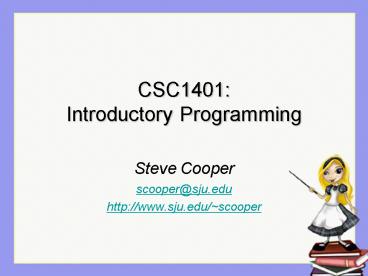CSC1401: Introductory Programming PowerPoint PPT Presentation
1 / 23
Title: CSC1401: Introductory Programming
1
CSC1401Introductory Programming
- Steve Cooper
- scooper_at_sju.edu
- http//www.sju.edu/scooper
2
Overview
- Course description (slides 3- 6)
- syllabus (see Handout)
- expectations
- tools
- Introductory Lecture (slides 7 - 23)
- What is a program?
- What is a programming language?
- Introduction to Alice
3
CSC1401
- Introduction to writing computer programs
- traditional
- object-oriented
- 3D animation programming
- Pixar and Disney style (film, movie)
- Interactive games (reasonably small)
4
CSC1401 - FS
- An introductory course
- No previous programming experience is required
5
Expectations
- Come to class
- Work with the text, handouts, and online content
- Complete the exercises, assignments, and labs
- Workouts designed to prepare you for the exams
- Do your own work on individual assignments you
may work with a partner on an assignment with
prior permission
6
Tools
- Textbook
- Learning to Program with Alice
- Other reading
- handouts, online references
- Software (available online, freeware)
- Alice
- Java
7
What is a program?
- A program is a sequence of instructions that
- tell the computer what to do
- tell another human being what you want the
computer to do - More formally, a program implements an algorithm.
- Algorithm a finite set of well-defined
instructions for accomplishing some task -
Wikipedia
8
Program Tasks
- Programs are written for various kinds of tasks
(not mutually exclusive) - solve a problem
- simulation
- game
- animation
9
What is a language?
- A system for communicating.
- Written languages use symbols (that is,
characters) to build words. - Parts of Language
- Vocabulary The entire set of words in the
language. - Syntax and grammar The ways in which the words
can be meaningfully combined - Semantics The actual meaning of words and
combinations of words -
Webopedia
10
Computer Languages
- Human languages are natural languages.
- Computers are not sophisticated enough to
understand natural languages. - In mathematics, logic and computer science, a
formal language is a set of finite-length words
(i.e. character strings) drawn from some finite
alphabet, with carefully defined vocabulary,
syntax, and semantics - Wikipedia
- There are many different kinds of computer
languages, including machine languages,
programming languages, and fourth-generation
languages. - Webopedia
11
Learning to write a program
- A program is written using a programming language
- We will learn to write programs using two
languages - Alice
- Java
12
Object Oriented Programming
- Different programming languages support different
styles of programming - In object-oriented programming, programmers can
think of a program as instructions that tell
interacting objects what to do - An object is a model of some artifact (product of
civilization) that can interact with other objects
13
In this course
- We will learn how to
- Initiate and control the interactions between
objects to - solve problems
- perform tasks
- tell stories in animations
- play games
- Modify and build objects
14
Supporting Skills to Develop
- Algorithmic Thinking and Expression
- Being able to read and write in two formal
languages - Alice (fourth-generation)
- Java (high-level or third generation)
- Abstraction
- Communicating complex ideas simply
- Decompose problems logically
- Appreciation of Elegance
- Many ways to solve a problem, but some are more
elegant than others
15
Introduction to Alice
- Use the software from the CD or can download
latest version from the web - www.alice.org
Alice is named in honor of Lewis
Carrolls Alice in Wonderland
16
Alice
- A modern programming tool
- 3-D graphics
- 3-D models of objects
- Animation
- Objects can be made to move around the virtual
world (a video game or simulation implemented in
3-D)
17
Demo Getting started
- Starting Alice
- Load and run a world
- What Alice Can Do (Examples)
- Amusement Park (Examples)
- Flight Simulator (Examples)
- LightDemo (Examples)
- Octopus (download)
- Lake Skater (Examples)
18
Kinds of Animations
- Two kinds of animations
- Movie
- Passive user watches the animation
- What Alice Can Do
- LightDemo
- Octopus
- Interactive
- Active user clicks on mouse, types a key on
keyboard - Actions of user are called events
- Flight Simulator
- Skater
19
Objects
- An "object" is a model of an artifact
- and can be identified as unique from other
things - there can be multiple objects that are similar,
but still unique - How is an object unique?
- has a name
- has properties
- width, height, color, location
- can perform actions (methods)
- associated actions it can perform
- tasks it can carry out
20
Object Parts
- Objects may be composed of parts (which are also
objects)
21
Class
- A class defines a particular kind of object
- Objects are categorized into classes
- Each object is
- an instance of the class.
- All objects in a class have similar properties
and generally can perform the same tasks.
peter
Person
paul
mary
spike
Dog
scottie
fluffy
22
Galleries
- Classes (3D models) are found in the galleries
- Local gallery (installed with the software)
- Minimum or complete options
- CD Gallery (only if CD is in the machine)
- Web gallery
23
For next class
- Activity
- Launch Alice on your computer and run some of the
example worlds. - Homework
- Read Chapter 1.1 and pages 73 - 74 of the text

